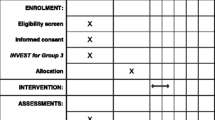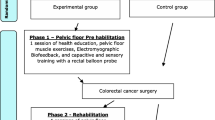PURPOSE: Biofeedback training has been shown as an effective therapeutic measure in patients with pelvic floor dyssynergia, at least in the short term. Long-term effects have received less attention. Moreover, its effects in patients with slow-transit constipation have been scarcely investigated. This study was designed to assess in an objective way the medium- and long-term effects of biofeedback and muscle training in patients with pelvic floor dyssynergia and slow-transit constipation. METHODS: Twenty-four patients (14 with pelvic floor dyssynergia and 10 with slow transit) meeting the Rome II criteria for constipation, and unresponsive to conventional treatments, entered the study. Clinical evaluation and anorectal manometry were performed basally and three months after a cycle of electromyographic biofeedback and muscle training; moreover, a clinical interview was obtained one year after biofeedback. Patients with slow-transit constipation also had colonic transit time reassessed at one year. RESULTS: Clinical variables (abdominal pain, straining, number of evacuations/week, use of laxatives) all significantly improved in both groups at three-month assessment; anorectal manometric variables remained unchanged, apart from a significant decrease of sensation threshold in the pelvic floor dyssynergia group and of the maximum rectal tolerable volume in the slow-transit constipation group. At one-year control, 50 percent of patients with pelvic floor dyssynergia still maintained a beneficial effect from biofeedback, whereas only 20 percent of those complaining of slow-transit constipation did so. Moreover, the latter displayed no improvement in colonic transit time. CONCLUSIONS: In our experience, patients with pelvic floor dyssynergia are likely to have continued benefit from biofeedback training in the time course, whereas its effects on slow-transit constipation seems to be maximal in the short-term course.
Similar content being viewed by others
REFERENCES
Drossman DA, Zhiming LI, Andruzzi E, et al. US Householder survey of functional gastrointestinal disorders: prevalence, sociodemography, and health impact. Dig Dis Sci 1993;38:1569-80
Stark ME. Challenging problems presenting as constipation. Am J Gastroenterol 1999;94:567-74
Surrenti E, Rath DM, Pemberton JH, Camilleri M. Audit of constipation in a tertiary referral gastroenterology practice. Am J Gastroenterol 1995;90:1471-5
Bartolo DC, Kamm MA, Kuijpers HC, Lubowski DZ, Pemberton JH, Rothenberger D. Working party report: defecation disorders. Am J Gastroenterol 1994;89:S154-9
Whitehead WE, Wald A, Diamant NE, et al. Functional disorders of the anus and rectum. In: Drossman DA, Corazziari E, Talley NJ, et al., eds. Rome II: the functional gastrointestinal disorders. McLean, VA: Degnon Associates, 2000:483-529
Bassotti G, Whitehead WE. Biofeedback, relaxation training, and cognitive behaviour modification as treatments for lower functional gastrointestinal disorders. Q J Med 1997;90:545-50
Azpiroz F, Enck P, Whitehead WE. Anorectal functional testing: review of collective experience. Am J Gastroenterol 2002;97:232-40
Bassotti G, Whitehead WE. Biofeedback as a treatment approach to gastrointestinal tract disorders. Am J Gastroenterol 1994;89:158-64
Enck P. Biofeedback training in disordered defecation: a critical review. Dig Dis Sci 1993;38:1953-60
Rao SS, Enck P, Loenig-Baucke V. Biofeedback therapy for defecation disorder. Dig Dis 1997;15(Suppl 1):78-92
Diamant NE, Kamm MA, Wald A, Whitehead WE. AGA technical review on anorectal testing techniques. Gastroenterology 1999;116:735-60
Bassotti G, Chistolini F, Morelli A. Biofeedback for pelvic floor dyssynergia: a functional therapeutic approach to a functional disorder. J Functional Syndromes 2002;2:100-3
Chiotakakou-Faliakou E, Kamm MA, Roy AJ, Storrie JB, Turner IC. Biofeedback provides long-term benefit for patients with intractable, slow and normal transit constipation. Gut 1998;42:517-21
Thompson WG, Longstreth GF, Drossman DA, Heaton KW, Irvine EJ, Muller-Lissner SA. Functional bowel disorders and functional abdominal pain. Gut 1999;45(Suppl II):II43-7
Whitehead WE, Wald A, Diamant NE, Enck P, Pemberton JH, Rao SS. Functional disorders of the anus and rectum. Gut 1999;45(Suppl II):II55-9
Whitehead WE, Forneris CA, Morris RL, Hanna-Pladdy B. Development of a questionnaire to identify patients meeting Rome criteria for functional gastrointestinal disorders. Dig Dis Sci (in press)
Chiarioni G, Bassotti G, Germani U, et al. Idiopathic megarectum in adults: an assessment of manometric and radiologic variables. Dig Dis Sci 1995;40:2286-92
Whitehead WE, Chaussade S, Corazziari E, Kumar D. Report of an international workshop on management of constipation. Gastroenterol Intl 1991;5:99-113
Koutsomanis D, Lennard-Jones JE, Roy AJ, Kamm MA. Controlled randomised trial of visual feedback versus muscle training without a visual display for intractable constipation. Gut 1995;37:95-9
Heymen S, Wexner SD, Vickers D, Nogueras JJ, Weiss EG, Pikarsky AJ. Prospective, randomized trial comparing four biofeedback techniques for patients with constipation. Dis Colon Rectum 1999;42:1388-93
Whitehead WE, Heymen S, Schuster MM. Motility as a therapeutic modality: biofeedback treatment of gastrointestinal disorders. In: Schuster MM, Crowell MD, Koch KL, eds. Schuster atlas of gastrointestinal motility in health and disease. 2nd ed. Hamilton: BC Decker Inc, 2002:381-97
Koutsomanis D, Lennard-Jones JE, Kamm MA. Prospective study of biofeedback treatment for patients with slow and normal transit constipation. Eur J Gastroenterol Hepatol 1994;6:131-7
Emmanuel AV, Kamm MA. Response to a behavioural treatment, biofeedback, in constipated patients is associated with improved gut transit and autonomic innervation. Gut 2001;49:214-9
Brown SR, Donati D, Seow-Choen F, Ho YH. Biofeedback avoids surgery in patients with slow-transit constipation: report of four cases. Dis Colon Rectum 2001;44:739-40
Wiesel PH, Dorta G, Cuypers P, et al. Patient satisfaction after biofeedback for constipation and pelvic floor dyssynergia. Swiss Med Wkly 2001;131:152-6
Ferrara A, De Jesus S, Gallagher JT, et al. Time-related decay of the benefits of biofeedback therapy. Tech Coloproctol 2001;5:131-5
Locke RG, Pemberton JH, Phillips SF. AGA technical review on constipation. Gastroenterology 2000;119:1766-78
Bassotti G, Betti C, Pelli MA, Morelli A. Prolonged (24-hour) manometric recording of rectal contractile activity in patients with slow transit constipation. Digestion 1991;49:72-7
Bassotti G, Chiarioni G, Germani U, Battaglia E, Morelli A. Endoluminal instillation of bisacodyl in patients with severe (slow transit type) is useful to test residual colonic propulsive activity. Digestion 1999;60:69-73
Bassotti G, Morelli A, Whitehead WE. Abnormal rectosigmoid myoelectrical response to eating in patients with severe idiopathic constipation (slow-transit type). Dis Colon Rectum 1992;35:753-6
Author information
Authors and Affiliations
Corresponding author
About this article
Cite this article
Battaglia, E., Serra, A., Buonafede, G. et al. Long-Term Study on the Effects of Visual Biofeedback and Muscle Training as a Therapeutic Modality in Pelvic Floor Dyssynergia and Slow-Transit Constipation. Dis Colon Rect 47, 90–95 (2004). https://doi.org/10.1007/s10350-003-0010-0
Published:
Issue Date:
DOI: https://doi.org/10.1007/s10350-003-0010-0




